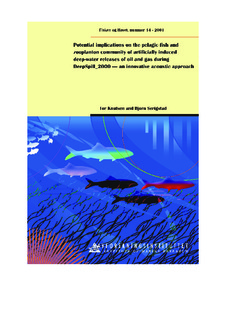| dc.description.abstract | During the DeepSpill_2000 field experiment (Johansen et al., 2001) oil and gas were artificially released on
several occasions from a water depth of 844 meters at the Helland-Hansen site in the Norwegian sea. Prior to
and during these releases a variety of sampling gear, echo sounders and other instrumentation were used to
monitor and obtain information on the environmental conditions, oil and gas plumes and the biological activity
in the experimental region. The main objective of the present work has been to provide a general description of
the biological community of the experimental region, and to provide information on the variability of biological
scatterers throughout the water column. By exploring and evaluating the short-term variability of the biological
scattering structures, the organisms therein and concurrently examine scattering from the released oil and gas,
new insights on how rising oil and gas might interact with the deep-water plankton and fish community of the
experimental region could be gained.
Acoustic scattering from oil and gas was easily observed during all experimental spill events and some
situations are presented in this report. The magnitude of the acoustic scattering from organisms inhabiting the
Deep Scattering Layer (DSL) between 300-500 m depth for an undisturbed situation and its natural variability is
documented. It is shown that rising oil-gas plumes certainly influences the otherwise quite homogeneous DSL
structure, although the precise mechanisms involved are still not revealed. When all scattering, from structures
that with certainty can be attributed to the released oil and gas were excluded, the remaining acoustic scattering
from the DSL seem to be nearly an order of magnitude higher compared to an undisturbed situation. The reason
for this is still uncertain, but some tentative hypotheses are formulated. The most plausible explanation seem to
be that a fraction of the released compounds and in particular gas bubbles, for various reasons have a prolonged
residence time within the region of the DSL, hence contributing significantly to the increased scattering
observed during the spills. | no_NO |
